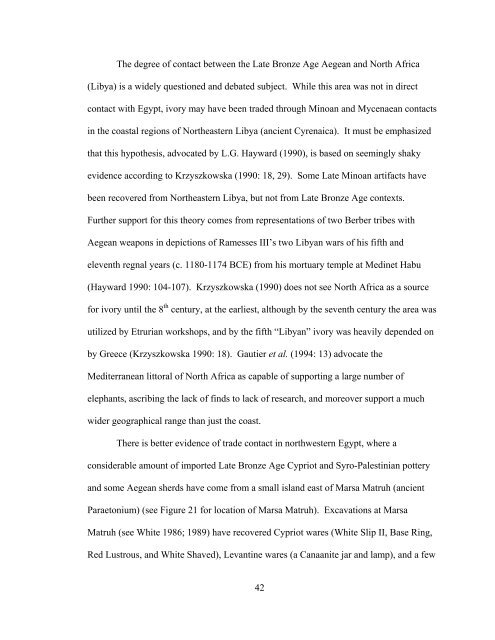Tracing the Source of the Elephant And Hippopotamus Ivory from ...
Tracing the Source of the Elephant And Hippopotamus Ivory from ...
Tracing the Source of the Elephant And Hippopotamus Ivory from ...
Create successful ePaper yourself
Turn your PDF publications into a flip-book with our unique Google optimized e-Paper software.
The degree <strong>of</strong> contact between <strong>the</strong> Late Bronze Age Aegean and North Africa<br />
(Libya) is a widely questioned and debated subject. While this area was not in direct<br />
contact with Egypt, ivory may have been traded through Minoan and Mycenaean contacts<br />
in <strong>the</strong> coastal regions <strong>of</strong> Nor<strong>the</strong>astern Libya (ancient Cyrenaica). It must be emphasized<br />
that this hypo<strong>the</strong>sis, advocated by L.G. Hayward (1990), is based on seemingly shaky<br />
evidence according to Krzyszkowska (1990: 18, 29). Some Late Minoan artifacts have<br />
been recovered <strong>from</strong> Nor<strong>the</strong>astern Libya, but not <strong>from</strong> Late Bronze Age contexts.<br />
Fur<strong>the</strong>r support for this <strong>the</strong>ory comes <strong>from</strong> representations <strong>of</strong> two Berber tribes with<br />
Aegean weapons in depictions <strong>of</strong> Ramesses III’s two Libyan wars <strong>of</strong> his fifth and<br />
eleventh regnal years (c. 1180-1174 BCE) <strong>from</strong> his mortuary temple at Medinet Habu<br />
(Hayward 1990: 104-107). Krzyszkowska (1990) does not see North Africa as a source<br />
for ivory until <strong>the</strong> 8 th century, at <strong>the</strong> earliest, although by <strong>the</strong> seventh century <strong>the</strong> area was<br />
utilized by Etrurian workshops, and by <strong>the</strong> fifth “Libyan” ivory was heavily depended on<br />
by Greece (Krzyszkowska 1990: 18). Gautier et al. (1994: 13) advocate <strong>the</strong><br />
Mediterranean littoral <strong>of</strong> North Africa as capable <strong>of</strong> supporting a large number <strong>of</strong><br />
elephants, ascribing <strong>the</strong> lack <strong>of</strong> finds to lack <strong>of</strong> research, and moreover support a much<br />
wider geographical range than just <strong>the</strong> coast.<br />
There is better evidence <strong>of</strong> trade contact in northwestern Egypt, where a<br />
considerable amount <strong>of</strong> imported Late Bronze Age Cypriot and Syro-Palestinian pottery<br />
and some Aegean sherds have come <strong>from</strong> a small island east <strong>of</strong> Marsa Matruh (ancient<br />
Paraetonium) (see Figure 21 for location <strong>of</strong> Marsa Matruh). Excavations at Marsa<br />
Matruh (see White 1986; 1989) have recovered Cypriot wares (White Slip II, Base Ring,<br />
Red Lustrous, and White Shaved), Levantine wares (a Canaanite jar and lamp), and a few<br />
42

















